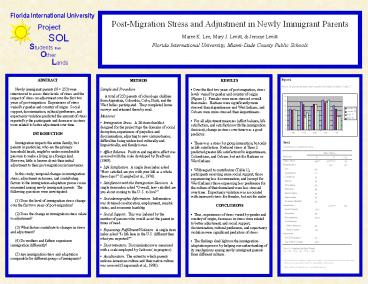Figure 1 - PowerPoint PPT Presentation
1 / 1
Title:
Figure 1
Description:
Immigration impacts the entire family, but parents in particular, who are the ... Immigration Stress. ... Satisfaction with the Immigration Decision. ... – PowerPoint PPT presentation
Number of Views:72
Avg rating:3.0/5.0
Title: Figure 1
1
Post-Migration Stress and Adjustment in Newly
Immigrant Parents Maree K. Lee, Mary J. Levitt,
Jerome Levitt Florida International
University, Miami-Dade County Public Schools
Students from Other Lands
Figure 1 Stress by parent gender and country of
origin at times 1 and 2
ABSTRACT Newly immigrant parents (N
253) were interviewed to assess their levels of
stress and the impact of stress on adjustment
over the first two years of post-migration.
Experiences of stress varied by gender and
country of origin. Social support,
discrimination, cultural preference, and
expectancy violation predicted the amount of
stress reported by the participants and decreases
in stress were related to better adjustment over
time. INTRODUCTION Immigration impacts
the entire family, but parents in particular, who
are the primary household heads, might be under
considerable pressure to make a living in a
foreign land. However, little is known about
their initial adjustment to their post-migration
circumstances. In this study, temporal
changes in immigration stress, adjustment
outcomes, and contributing factors to the
immigration-adaptation process were examined
among newly immigrant parents. The following
questions were investigated (1) Does
the level of immigration stress change over the
first two years of post-migration? (2)
Does the change in immigration stress relate to
adjustment? (3) What factors contribute
to changes in stress and adjustment? (4)
Do mothers and fathers experience immigration
differently? (5) Are immigration stress
and adaptation comparable for different groups of
immigrants?
- METHOD
- Sample and Procedure
- A total of 253 parents of school-age
children from Argentina, Colombia, Cuba, Haiti,
and the West Indies participated. They completed
home surveys and returned them by mail. - Measures
- Immigration Stress. A 26-item checklist
designed for the project taps the domains of
social disruption, experiences of prejudice and
discrimination, adjusting to new circumstances,
difficulties being understood culturally and
linguistically, and family issues. - Affect Balance. Positive and negative affect
was assessed with the scale developed by Bradburn
(1969). - Life Satisfaction. A single item index asked
How satisfied are you with your life as a whole
these days? (Campbell et al., 1976). - Satisfaction with the Immigration Decision. A
single item index asked Overall, how satisfied
are you about coming to the U. S. to live? - Sociodemographic Information. Information was
obtained on education, employment, marital
status, and economic hardship - Social Support. This was indexed by the number
of persons who would assist the parent in times
of need.
- RESULTS
- Over the first two years of post-migration,
stress levels varied by gender and country of
origin (Figure 1). Females were more stressed
overall than males. Haitians were significantly
more stressed than Argentineans and West Indians,
and Cubans were more stressed than Argentineans. - For all adjustment measures (affect balance,
life satisfaction, and satisfaction with the
immigration decision), change in stress over time
was a good predictor. - There was a stress by group interaction, but
only in life satisfaction. Reduced stress at
Time 2 predicted greater life satisfaction for
Argentineans, Colombians, and Cubans, but not for
Haitians or West Indians. - With regard to contributors (Table 1),
participants receiving more social support, those
experiencing less discrimination, and (except for
West Indians) those expressing less preference
for the culture of their homeland were less
stressed over time. Expectancy violation was
associated with increased stress for females, but
not for males. - CONCLUSIONS
- Thus, experiences of stress varied by gender
and country of origin, decreases in stress were
related to better adjustment, and social support,
discrimination, cultural preference, and
expectancy violation were significant predictors
of stress. - The findings shed light on the
immigration-adaptation process by helping our
understanding of its mechanisms among newly
immigrant parents from different cultures.































